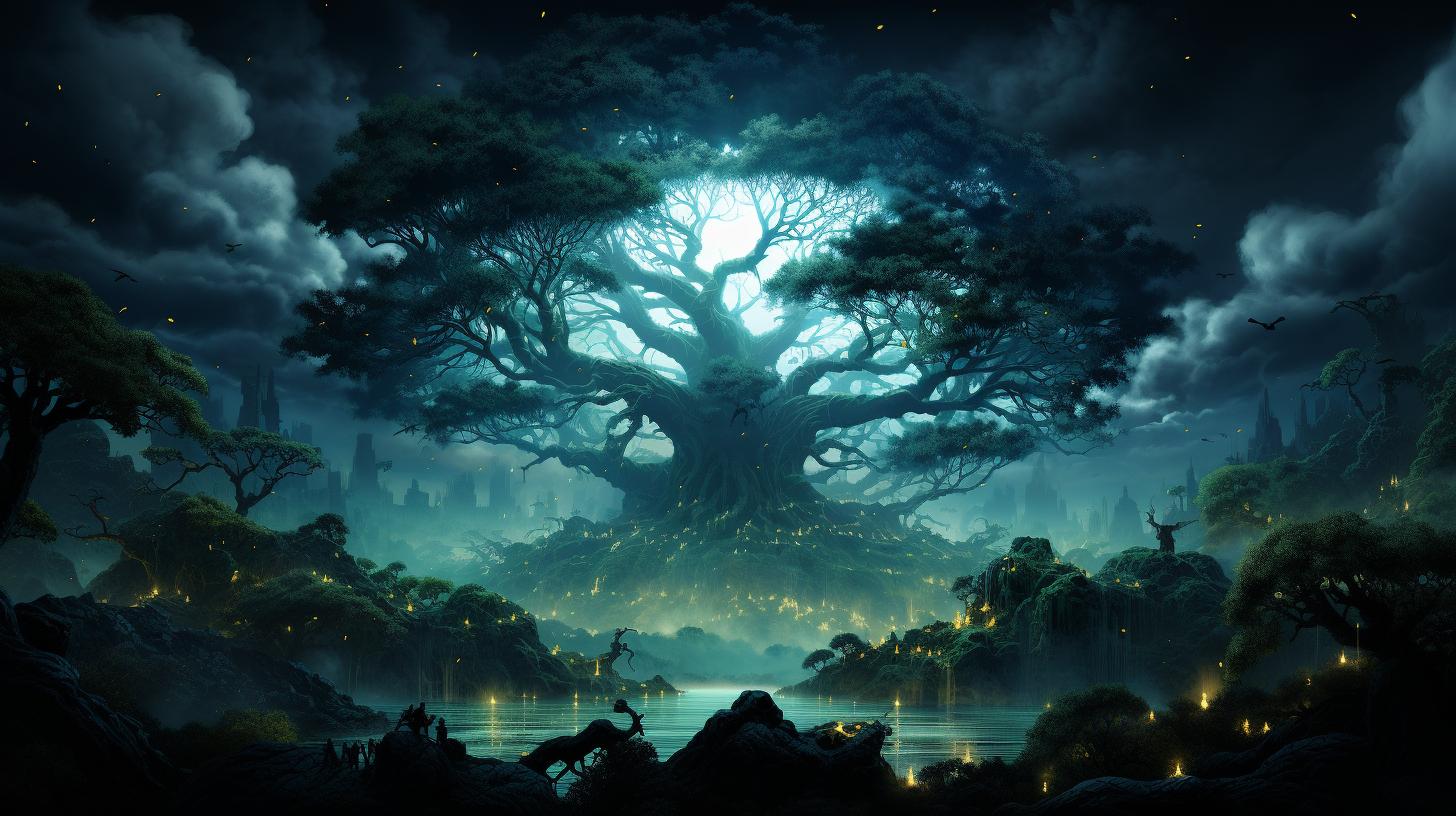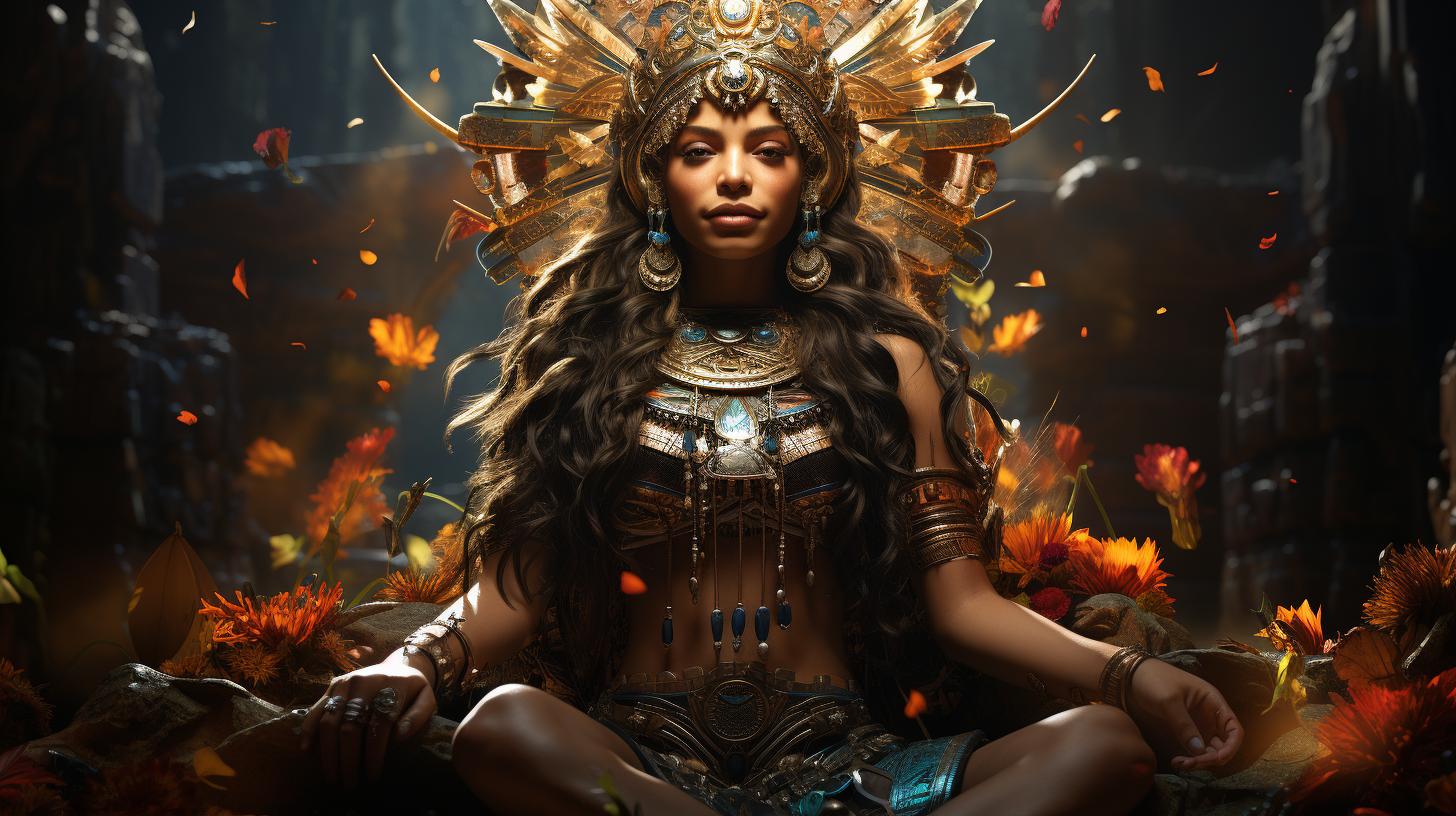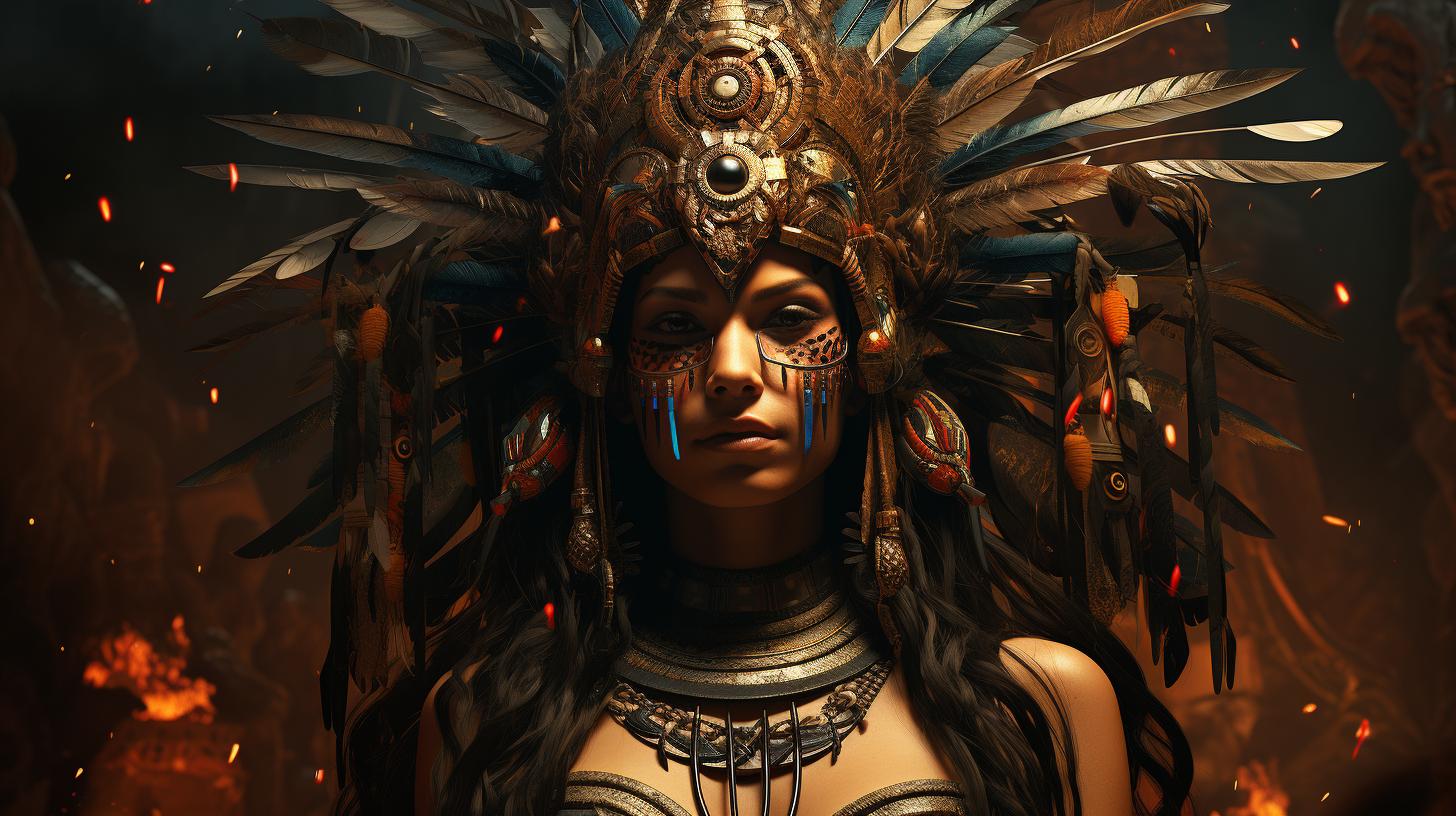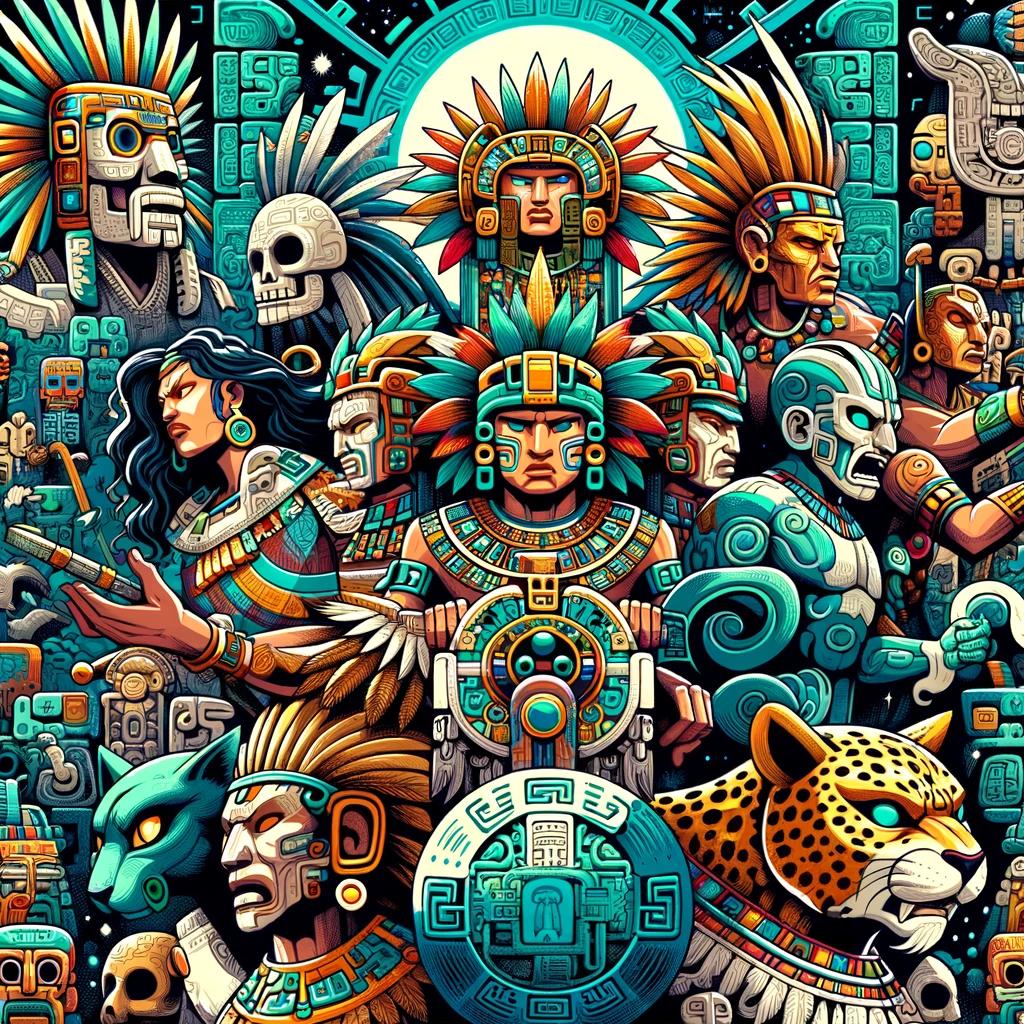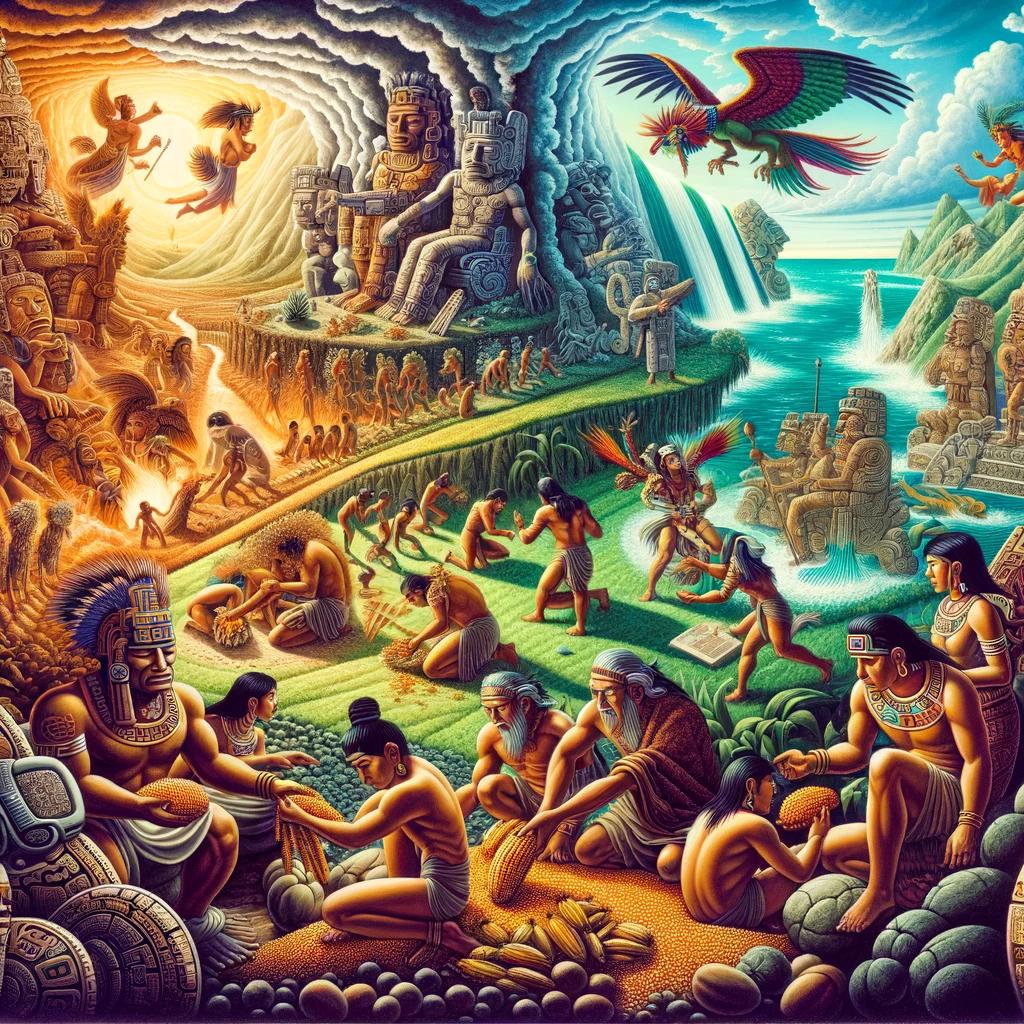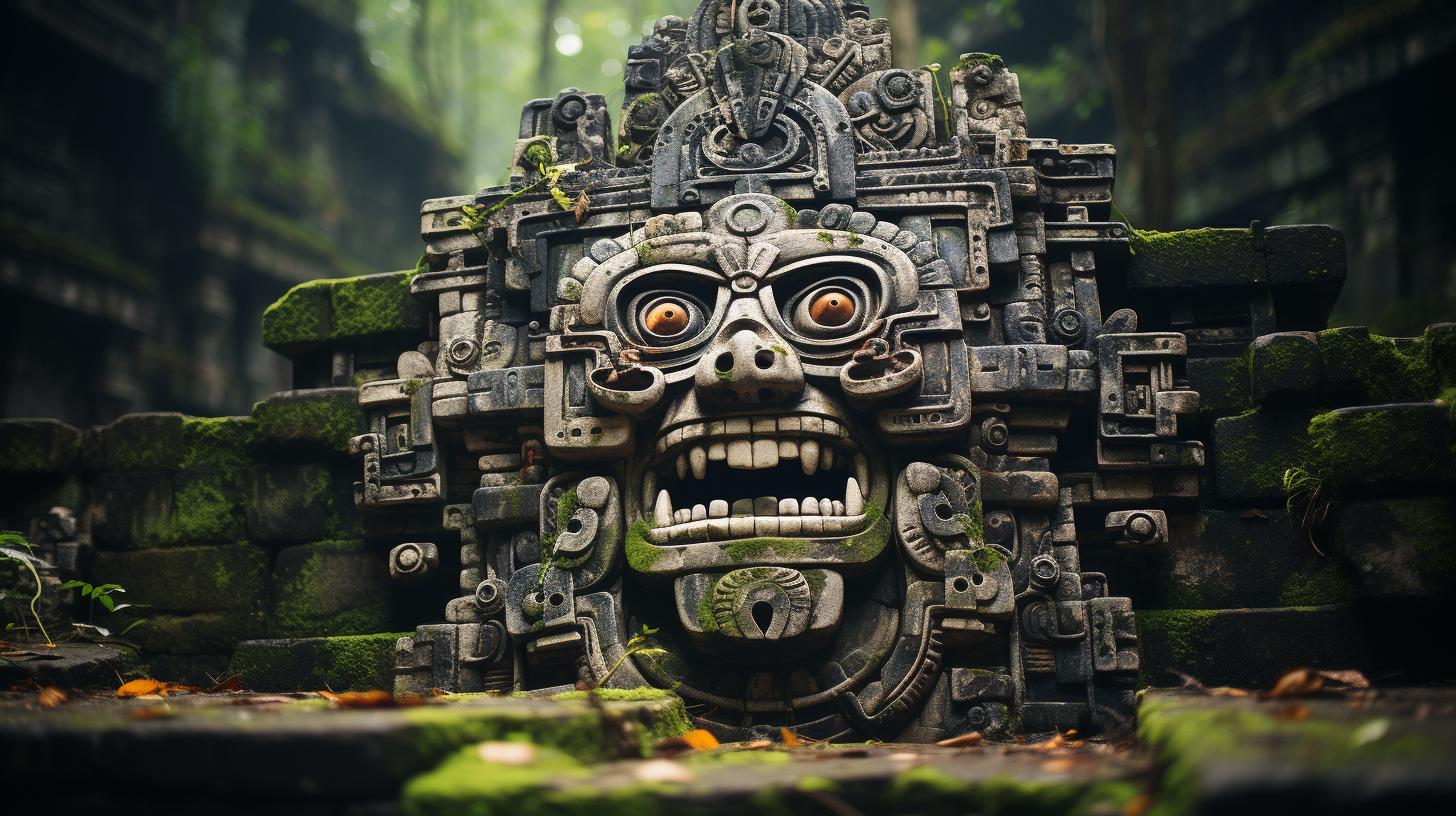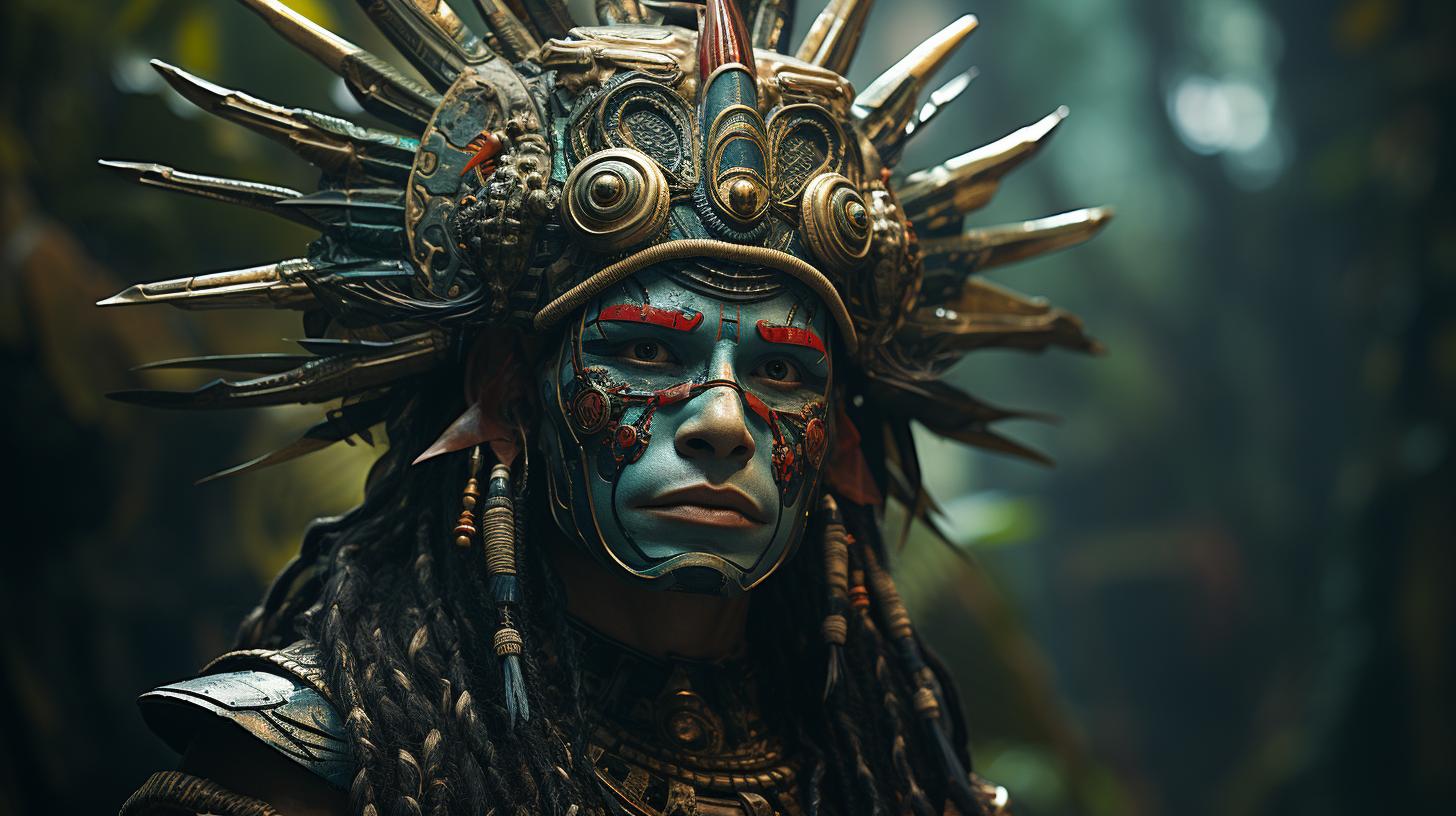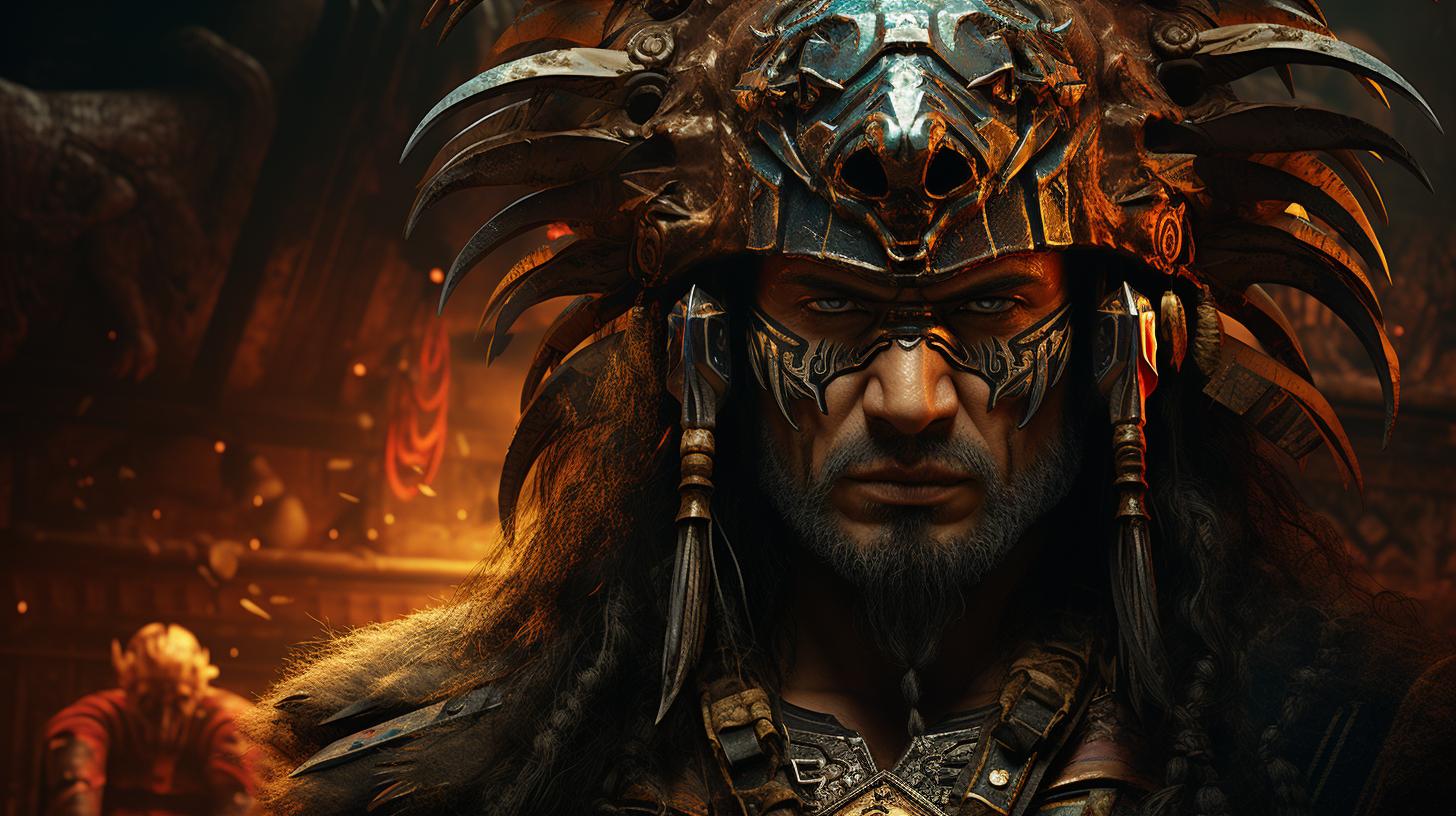Zipacna Mayan God: The Malevolent Giant of the Mountains
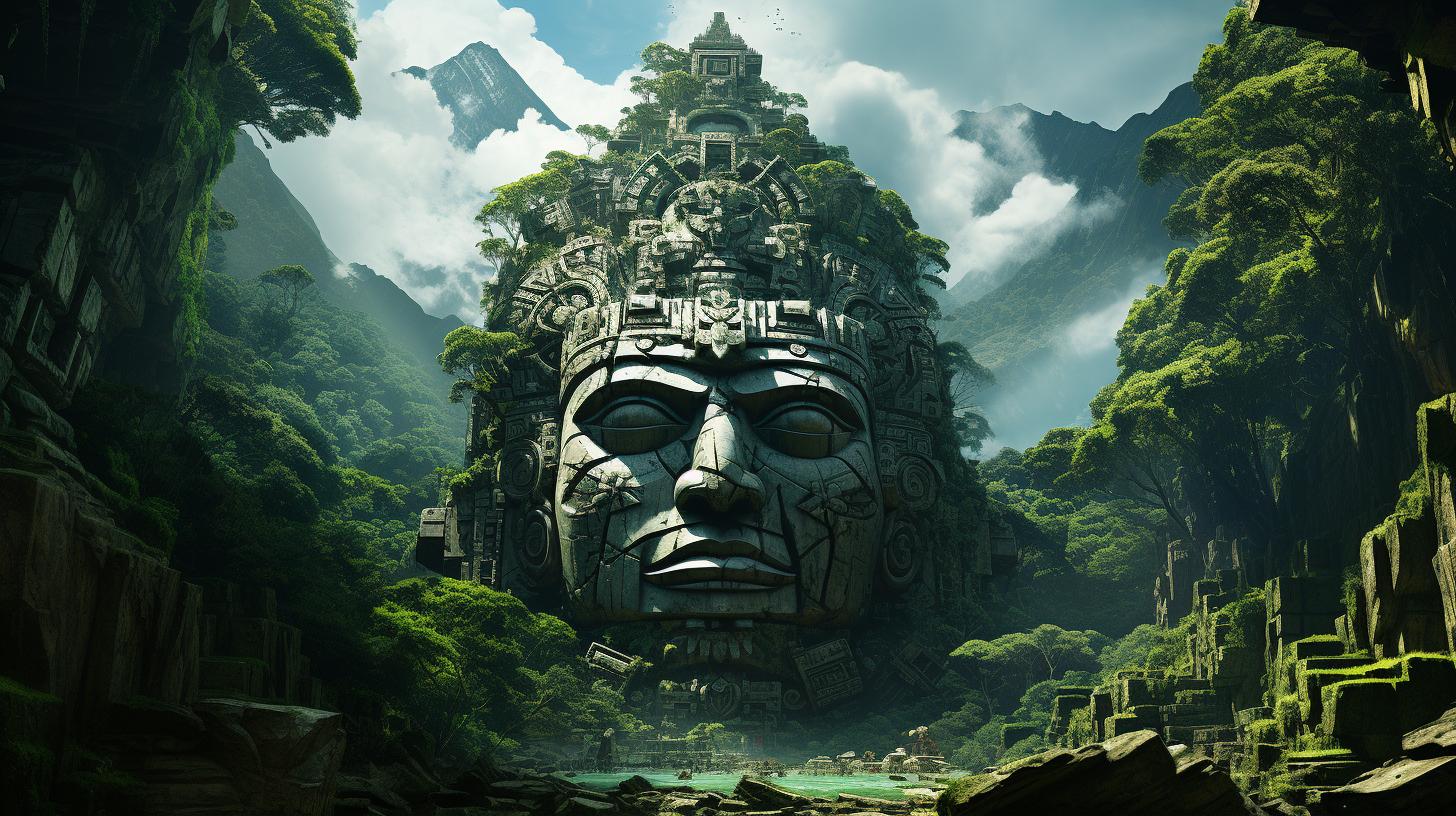
Zipacna, the Mayan god of the mountains, is a malevolent and colossal being in Mayan mythology. He claimed to be the creator of mountains, although this was likely just boasting.
Zipacna’s arrogance and cruelty led him to kill four hundred brave warriors by sitting on them, a merciless way to die. He was ultimately defeated by the Hero Twins, who tricked him into a trap and crushed him with a falling mountain.
Zipacna’s demonic nature and reputation for violence made him feared by the Maya.
Zipacna: The Malevolent Giant
Zipacna, known as the Malevolent Giant, is a prominent figure in Mayan mythology. This section explores the description, characteristics, and role of Zipacna as the Mayan god of the mountains, as well as his relationship with Vucub Caquix and Cabrakan.
Description and Characteristics of Zipacna
Zipacna, often depicted as a malicious and enormous deity, possessed immense strength and power. He was known for his malevolence and cruelty towards both humans and other gods. Zipacna’s physical appearance was that of a formidable giant, instilling fear and awe in those who encountered him.
Zipacna’s Role as the Mayan God of the Mountains
As the Mayan god of the mountains, Zipacna claimed to be the creator of these majestic natural formations. Although his boastful claims were met with skepticism, there was no denying his association with the earth and its rocky formations.
The mountains were believed to be his domain, and he reveled in their grandeur and power.
Zipacna’s Relationship with Vucub Caquix and Cabrakan
Zipacna was the son of Vucub Caquix, the Mayan god of the Underworld, and the brother of Cabrakan, the god of earthquakes. The dynamics between Zipacna, Vucub Caquix, and Cabrakan played a significant role in Mayan mythology, with conflicts and tensions arising from their shared lineage and differing powers.
The Stories of Zipacna
Zipacna’s Claim as the Creator of Mountains
Zipacna, the malevolent giant of Maya mythology, boasted of being the creator of mountains, although it is believed to be mere bragging. His arrogance led him to assert his role as the master sculptor of the Earth’s majestic peaks.
This claim instilled fear and awe among the Maya people, who saw his immense power as a representation of their rugged landscapes.
Zipacna’s Cruelty and Acts of Violence
Zipacna was infamous for his cruelty and displayed an insatiable thirst for violence. He took pleasure in murdering and causing suffering. One heinous act was his merciless slaying of four hundred valiant young warriors, callously ending their lives by brutally sitting on them.
Such an act of heartlessness and sadism solidified his demonic reputation among the Maya.
Zipacna’s Defeat by the Hero Twins
The tyrannical reign of Zipacna came to a halt at the hands of the legendary Hero Twins, Hunahpu and Ixbalanque. These cunning brothers devised a cunning plan to ensnare Zipacna, luring him with a delectable artificial crab.
Falling for their trap, Zipacna found himself trapped beneath a collapsing mountain, crushed under the weight and power of nature itself. This victorious encounter signaled the end of Zipacna’s terror and marked a triumph for justice and the well-being of the Maya people.
Zipacna and the Heroes Gemelos
Zipacna, the malevolent giant of the Mayan pantheon, faced formidable adversaries in the Hero Twins, Hunahpu and Ixbalanque. These heroic twins were known for their cunning and bravery, and their encounters with Zipacna became the stuff of legend.
The Hero Twins: Hunahpu and Ixbalanque
Hunahpu and Ixbalanque were twin brothers who possessed exceptional powers and were chosen by the gods to confront the threatening reign of Zipacna. Gifted with intelligence and extraordinary skills, they embarked on a mission to rid the world of Zipacna’s destructive presence.
The Traps and Strategies Used by the Hero Twins to Defeat Zipacna
In their pursuit of defeating Zipacna, the Hero Twins devised ingenious traps and strategies. They capitalized on Zipacna’s arrogance and utilized his weaknesses against him. By offering him an enticingly crafted artificial crab, they lured Zipacna into a trap that ultimately led to his downfall.
The Hero Twins also took advantage of their environment, manipulating the natural forces to their advantage. They orchestrated the collapse of a nearby mountain, burying Zipacna under its colossal weight.
The Final Confrontation: Zipacna’s Defeat and Transformation
Although Zipacna was a formidable adversary, the Hero Twins emerged victorious in their final confrontation.
They unleashed an overwhelming avalanche of earth and stone, effectively burying him and transforming his body into solid rock. This triumph marked the end of Zipacna’s reign of terror and restored peace to the Maya people.
Zipacna in Mayan Culture
Zipacna and the Fear of his Demonic Nature
Within Mayan culture, Zipacna was a figure that instilled fear due to his demonic attributes. His cruel and violent nature made him a source of terror for the Maya people.
Believed to reside deep within the mountains, Zipacna would prey on unsuspecting travelers, taking pleasure in their suffering and demise. While the Mayan gods were not always benevolent, demons like Zipacna were considered even more malevolent.
The extreme evilness of Zipacna’s character led to the gods’ deep disdain for him.
Zipacna’s Association with the Earth, Mountains, and Strength
Zipacna was closely associated with the earth, mountains, and strength in Mayan mythology. His ability to construct and move mountains showcased his immense power and influence over the natural world.
The Maya believed that Zipacna’s actions directly impacted the stability of the earth, often causing chaos and destruction. This association with the forces of nature and his embodiment of strength further contributed to the reverence and fear surrounding Zipacna.
Different Interpretations and Representations of Zipacna in Mayan Art and Texts
- Mayan Art: In Mayan art, Zipacna is often depicted as a fearsome creature, portrayed as a giant with menacing features. Some representations show him with a crocodile or caiman-like appearance, highlighting his association with water and the dangers lurking within it.
He is sometimes depicted with a headgear adorned with feathers, symbolizing his connection to the natural world.
- Mayan Texts: Mayan texts contain stories and myths that depict Zipacna and his exploits.
The texts often present him as a malevolent deity, embodying evil and chaos. These narratives provide deeper insights into the beliefs and fears of the Maya people regarding Zipacna and his role in their cosmology.
- Symbolism: Zipacna also carries symbolic significance in Mayan culture.
His portrayal as a malevolent giant serves as a cautionary tale, warning against arrogance and cruelty. His defeat by the Hero Twins represents the triumph of good over evil and the restoration of balance in the natural order.
Zipacna and the Mayan Pantheon
Zipacna, the malevolent giant of the mountains, held a significant role in the intricate hierarchy of the Mayan gods.
Let’s explore the role of Zipacna in the Mayan gods hierarchy, the interactions between Zipacna and other Mayan gods, and Zipacna’s connection with death and war in Mayan beliefs.
The Role of Zipacna in the Mayan Gods Hierarchy
Within the Mayan pantheon, Zipacna occupied a prominent position as a deity associated with the forces of nature. He was revered for his power to construct and move mountains, symbolizing the immense strength and impact of geological formations on human lives.
As the god of the mountains, Zipacna commanded authority over the Earth and played a crucial role in shaping the landscape.
The Interactions between Zipacna and Other Mayan Gods
Zipacna’s position in the Mayan pantheon brought him into contact with other gods, both benevolent and malevolent. He often clashed with his brother Cabrakan, the god of earthquakes, as they represented opposing forces – creation and destruction.
This eternal struggle created a delicate balance, reminding the Maya of the constant changes and challenges in the natural world.
Moreover, Zipacna’s connections extended beyond his immediate family. He interacted with various deities related to agriculture, fertility, and warfare.
These interactions played a significant role in the cycle of life and death, as agriculture provided sustenance, fertility ensured growth, and warfare protected the Mayan civilization.
Zipacna’s Connection with Death and War in Mayan Beliefs
In Mayan beliefs, Zipacna’s connection with death and war was complex and multifaceted.
While he was not primarily associated with these aspects, his inherent malevolence and cruelty made him a formidable figure in the realm of war. The Maya believed that Zipacna’s actions and intentions influenced the outcomes of battles and conflicts.
Furthermore, the association between Zipacna and death stemmed from his role as a symbol of constant change and transformation. The destruction and creation of mountains represented the cyclical nature of existence, where death and rebirth were intertwined.
The Maya viewed Zipacna as a powerful deity capable of both granting and taking away life.
By examining Zipacna’s role within the Mayan gods hierarchy, his interactions with other deities, and his connection with death and war, we gain a deeper understanding of the complex belief system of the Maya and the significance of Zipacna in their spiritual framework.
Modern Interpretations and Legacy of Zipacna
Zipacna in Popular Culture and Contemporary Art
Zipacna, the malevolent giant of Mayan mythology, continues to captivate modern audiences through its representation in popular culture and contemporary art. Artists, writers, and filmmakers have been inspired by Zipacna’s intriguing character and mythical significance, incorporating it into various forms of entertainment.
Zipacna’s imposing stature and demonic nature have made it a compelling figure in fantasy literature and graphic novels. Its portrayal as a formidable antagonist in these works showcases the enduring fascination with its malevolence and power.
Moreover, Zipacna’s enigmatic presence has also found its way into contemporary art, with many artists exploring its symbolism and mythical attributes. Paintings, sculptures, and installations featuring Zipacna often emphasize its association with mountains, strength, and the primal forces of nature.
The Relevance of Zipacna’s Myth in Modern Understanding of Maya Civilization
The myth of Zipacna holds significant cultural and historical value, providing insights into the beliefs and worldview of the ancient Maya civilization. Understanding the legacy of Zipacna allows for a deeper comprehension of their religious practices, cosmology, and the interplay between humans and deities.
Furthermore, Zipacna’s mythology serves as a reminder of the complexity and diversity of ancient belief systems. By studying and analyzing Zipacna’s role in Mayan cosmogony, researchers can gain a broader understanding of the spiritual and cultural dimensions that shaped Maya society.
Today, scholars continue to explore and interpret Zipacna’s myth, shedding light on the importance of mythology in shaping the historical narrative and preserving the legacy of ancient civilizations like the Maya.
- Zipacna’s representation in popular culture reflects the enduring fascination with its character and mythological significance.
- Contemporary artists use Zipacna’s symbolism to explore themes of strength, nature, and spirituality.
- Studying Zipacna’s mythology contributes to a deeper understanding of Maya civilization’s religious beliefs and cultural practices.
- Zipacna’s myth serves as a reminder of the complexity and diversity of ancient belief systems.
- Exploring Zipacna’s legacy helps preserve the historical narrative of the Maya and their rich mythological heritage.
.












